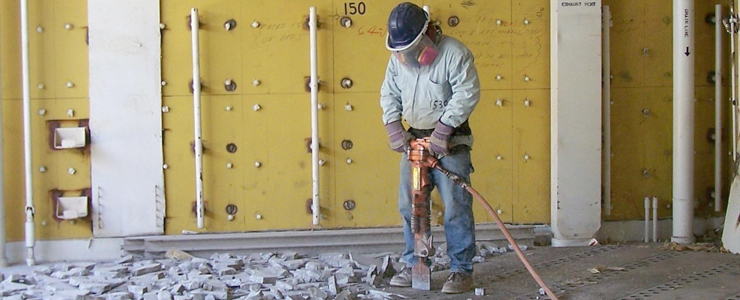By: Benjamin Jelin PhD, MPH, Sr. Industrial Hygienist
Note: Implementation of this regulation may be affected by guidance to agencies in the “Regulatory Freeze Pending Review” memorandum (January 20, 2017).
Compliance Date Approaching!
What is Crystalline Silica?
Crystalline silica (SiO2) is a naturally occurring compound commonly found in soil, sand, rock and other materials in nature. It is ubiquitous in the general environment and makes up most of the Earth’s crust. This compound is used in a variety of building materials including, but not limited to, glass, stone, rock, slate, concrete, industrial sand, tile, plastic composites, wallboard joint compounds, caulking, plaster and many more.
Respirable crystalline silica is approximately 100 times smaller than the sand usually found on beaches. Its small aerodynamic diameter allows for the crystalline silica to be conducted to the respirable gas-exchange region of the lungs. The main forms of crystalline silica that are regulated by OSHA are quartz, cristobalite, and tridymite.
Why Crystalline Silica?
Respirable crystalline silica has been identified as an occupational hazard as early as the 1700s by Dr. Bernadino Ramazzini. Over-exposure to respirable crystalline silica causes the development of silicosis, an irreversible fibrogenic lung disease which can lead to severe pulmonary impairment or even death. Additionally, respirable crystalline silica is an IARC Group 1 Known Human Carcinogen. It has been epidemiologically linked to further severe morbidities including autoimmune disorders, kidney disease, enlargement of the heart, and other pulmonary diseases.
How Are Workers Exposed?
Exposure to respirable crystalline silica occurs during the cutting, sawing, grinding, drilling, or any other operation that aerosolizes the compound into the breathing zone of an employee. Aerosolization can occur during regular construction operations, housekeeping activities, bulk material storage/transfer, and even in windy and dusty environments.
What Does the OSHA §1926.1153 Respirable Crystalline Silica Final Rule Do?
- Implements an action of level of 25 µg/m3 and a Permissible Exposure Limit (PEL) of 50 µg/m3 as an 8-hour time-weighted average (TWA).
- Provides a table (Table 1) of identified workplace practices, engineering controls, and worker personal protective equipment (PPE) that are exempt from exposure monitoring. NOTE: If your work practice involves the generation of respirable crystalline silica dust and it is not included on Table 1, you must conduct an exposure assessment.
- Defines exposure assessment and sampling requirements for non-exempted activities including the use of objective data and initial assessments. Results of exposure assessments must be shared with employees within five (5) days of exposure assessment.
- Requires that engineering and work practice controls be utilized to reduce employee exposure to below the new PEL, unless the employer can demonstrate the controls are not feasible. Even if the engineering and work practice controls are not able to reduce the employee exposure levels to below the PEL, those controls and practices must still be used in addition to respiratory protection.
- Requires a written exposure control program for each site and a competent person (someone who is trained and able to recognize respirable crystalline silica hazards and has the authority to implement controls) to implement and oversee the program.
- Limits the housekeeping activities to wet sweeping, HEPA-filtered vacuuming, and other methods that minimize the likelihood of exposure; unless these practices are not feasible. Prohibited activities include dry sweeping/brushing and use of compressed air without dust capture system (unless there is no feasible alternative).
- Defines medical surveillance requirements for workers who will be required to wear respirators for greater than or equal to 30 days per year under the respirable crystalline silica rule.
- Requires communication of respirable crystalline silica hazards and employee training.
- Defines recordkeeping requirements.
Please refer to §1926.1153 for a full enumeration of the requirements under this rule.
When Do I Need to be Compliant with the OSHA Respirable Crystalline Silica Rule?
June 23, 2017
What Will be the Legal Ramifications of this Standard?
This may be a liability area for potential torts by present or former construction employees. The new PEL was developed based on NIOSH recommendations from 1974, which provided a respirable crystalline silica Recommended Exposure Limit of 50 µg/m3 as a 10-hour TWA (40-hour work week). Therefore, this new standard is not based on new scientific knowledge.
As our understanding of the potential associated non-silicosis and non-cancer diseases are recognized in academic literature, we believe that retrospective and prospective claims and lawsuits will be forthcoming. There may even be some legal “double dipping.” For example, an employee might claim or sue separately for exposure to both asbestos and silica. The way forward is treacherous and may require further legal counsel as claims arise.
Based on these potential legal outcomes, NV5 recommends the following actions:
- Maintain any exposure records indefinitely.
- Do not wait for OSHA enforcement to kick in to begin conducting employee exposure assessment and fugitive dust release monitoring.
- Begin designing and implementing occupational health programs including medical evaluations, surveillance, and exposure monitoring. Make sure to get medical assessments prior to first day of work involving respirable crystalline silica. The rule requires medical assessment within 30 days of the employee’s first assignment; however, we believe it is prudent to get employees assessed prior to any work so as to not be held responsible for previous exposure and damage to worker health.
- Stay abreast of all national consensus standards and best practices to incorporate them into your exposure control program.
What Can NV5 Do for You?
NV5 can provide you with a full range of occupational safety and health consultation services relating to the new OSHA Respirable Crystalline Silica Rule to limit your liability including:
- Regulatory interpretation and exposure control plan development;
- Compliance program audits;
- Development of objective data as defined under the rule;
- Initial and ongoing exposure assessment;
- Onsite supervision/oversight as the competent person; and
- Expert witness services.

